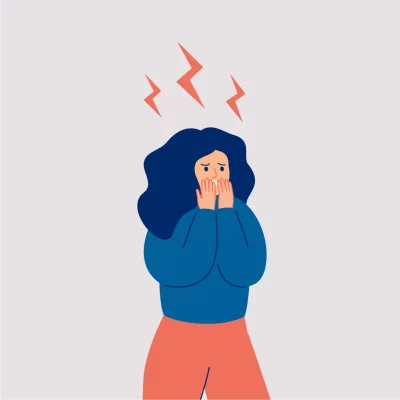Do you suffer from an anxiety or panic disorder, and your body always feels on the verge of an attack? Have you ever felt anxious or stressed out and noticed that your heart rate increased, your breathing became shallow, and your muscles tensed up? These physical symptoms are signs of a hyperactive sympathetic nervous system, the body’s natural response to stress.
When the sympathetic nervous system stays activated for too long, it can lead to various physical and mental health issues, including high blood pressure, inflammation, anxiety, depression, and more.
The good news is that there are simple exercises you can do to activate the vagus nerve, which is a crucial component of the parasympathetic nervous system, also known as the “rest and digest” system. Stimulating the vagus nerve can promote relaxation, lower stress levels, boost immunity, and improve overall health and wellbeing.
In this article, we’ll explore what the vagus nerve is, why it’s crucial, the top vagus nerve exercises, and the health benefits you can expect from practicing these exercises.
What is the Vagus Nerve?
The vagus nerve is one of the most critical nerves in the body. It is responsible for controlling many different functions throughout the body. It is the longest nerve in the body and extends from the brainstem down to the abdomen, connecting with various organs, muscles and glands.
The primary function of stimulating the vagus nerve is to regulate the parasympathetic nervous system, which is responsible for the body’s “rest and digest” relaxation response. This response means that when the vagus nerve is activated, it helps to slow down the heart rate, lower blood pressure, and promote relaxation.
The vagus nerve is also responsible for controlling other bodily functions, including breathing, digestion, and immune system responses. It plays a crucial role in regulating inflammation levels in the body, which can impact overall health and wellbeing.
The vagus nerve is a crucial component of the nervous system and plays a vital role in promoting relaxation, reducing stress, and improving overall physical and mental health.
Why are Vagus Nerve Exercises Important?
Stress and anxiety can significantly impact the body and nervous system. When we experience stress or anxiety, our body goes into “fight or – flight response” mode, releasing hormones such as cortisol and adrenaline. This response can cause physical symptoms such as rapid breathing, increased heart rate, muscle tension, and digestive issues. Over time, chronic stress and anxiety can lead to more severe health problems, including high blood pressure, heart disease, and mental health disorders.
Explanation of how vagus nerve exercises can promote relaxation, reduce stress, and improve overall physical and mental health
Vagus nerve exercises can positively impact our physical and mental health by promoting relaxation and reducing stress. When we activate the vagus nerve, it sends signals to the brain to release calming neurotransmitters such as GABA and serotonin, which can help us feel more relaxed and less stressed.
Research shows that practicing vagus nerve exercises can improve heart rate variability, an essential measure of our body’s ability to respond to stress. By improving heart rate variability, we become more resilient and better handle stressful situations.
Vagus nerve exercises can also have a positive impact on our mental and physical health. Studies have found that these exercises can reduce symptoms of anxiety and depression, improve mood, and enhance cognitive function.
Incorporating vagus nerve exercises into our daily routine can reduce stress, promote relaxation, and improve our overall physical and mental health. It’s important to prioritize self-care and take steps to manage our stress levels in today’s fast-paced world.
The Top 5 Vagus Nerve Exercises
There are various types of the vagus nerve stimulation exercises that you can try at home to help promote relaxation, reduce stress, and improve overall physical and mental health. Here are some examples:
Breathing exercises:
There are different breathing exercises, but all aim to slow down your breath to stimulate the vagus nerve. A simple breathing exercise is diaphragmatic breathing, where you breathe deeply through your nose and exhale slowly through your mouth while focusing on your belly rising and falling.
You can also try alternate nostril breathing, inhaling through one nostril and exhaling through the other, switching nostrils after each breath. These deep breathing exercises are best performed in a quiet room where you can sit or lie down comfortably.
Meditation:
To meditate:
- Find a quiet space where you won’t be disturbed.
- Sit comfortably with your back straight and close your eyes.
- Focus on your breath and observe your thoughts without judgment. If your mind wanders, gently bring your attention back to your breath.
- Start with just a few minutes a day and gradually increase the time as you feel comfortable.
There are many apps and guided meditations available that can help you start practicing this vagus nerve exercise.
Yoga:
Yoga combines breathwork with physical postures and stretches that help release tension in the body and promote relaxation. Certain poses, like downward dog, child’s pose, and forward fold, can stimulate the vagus nerve.
To practice yoga:
- Find a quiet space
- Wear loose-fitting clothing
- Follow along with a yoga video or class
- Or create your routine based on the poses you enjoy.
Humming, Chanting, or Singing:
Humming, chanting and singing have been shown to activate the vagus nerve. Simply humming to yourself while you do your daily activities can be an easy way to incorporate this exercise into your life. Alternatively, you can try chanting “Om” or another soothing sound for a few minutes a day, or sing your favorite song while you do the dishes.
The vagus nerve, one of the longest nerves in the body, has many branches running through the torso, neck, and head. One of these branches connects to the vocal cords. This vagus nerve exercise directly stimulates the vagus nerve, which can quickly deliver a sense of calm over the body.
Cold-water immersion:
Cold water immersion involves exposing your body to cold water briefly, such as taking a cold shower or a dip in a cold pool. This exercise can help stimulate the fight-or-flight stress response, and build resilience to stress.
While cold water immersion does initially activate the fight-or-flight response of the sympathetic nervous system, it can also help to stimulate the parasympathetic nervous system.
When the body is exposed to cold water, it triggers a physiological response known as the mammalian diving reflex. This reflex causes the heart rate to slow down and blood vessels to constrict, which helps conserve oxygen and redirect blood flow to essential organs like the brain and heart.
As the body adapts to the cold water, the parasympathetic nervous system becomes more dominant, promoting relaxation and reducing stress. Studies have shown that regular cold water immersion can improve heart rate variability, which is an indicator of our body’s ability to respond to stress.
Overall, incorporating these exercises to increase vagus nerve stimulation into your daily routine can promote relaxation, reduce stress, and improve your overall health and wellbeing. Remember to start slowly and gradually increase the intensity and duration of each exercise over time.
How to Incorporate Vagus Nerve Exercises into Daily Life
Incorporating vagus nerve exercises into your daily life can be easy and doesn’t have to take up a lot of time. The key to incorporating these exercises into your daily routine is to find what works best for you and make it a habit. By taking just a few minutes daily to focus on your breath, move your body, or practice mindfulness, you can reduce stress, promote relaxation, and improve your overall health and wellbeing.
Other Vagus Nerve Treatments
While vagus nerve exercises are a popular way to stimulate the vagus nerve, there are also other treatments that can be used to support vagus nerve function. Here are some examples:
Vagus nerve stimulation (VNS):
This is a medical treatment that involves implanting a device in the chest that sends electrical impulses to the vagus nerve. VNS has been shown to be effective for treating conditions such as epilepsy, depression, and migraines.
There are also devices that promote VNS that are not an implant. Rather, they are worn around the neck and offer significant vagus nerve stimulation without the invasiveness of an implant. This technology is still being researched, but it is a viable option with less risk than its alternative.
Acupuncture:
Acupuncture involves inserting thin needles into specific points on the body to promote healing and balance. Certain acupuncture points have been shown to stimulate the vagus nerve, reduce inflammation, and promote relaxation.
Massage:
Massage therapy can help reduce stress and increase relaxation, which can help activate the parasympathetic nervous system and stimulate the vagus nerve.
Chiropractic care:
Chiropractic adjustments can help promote spinal alignment and improve nerve function, which can indirectly support vagus nerve function.
Herbal remedies:
Certain herbs, such as ashwagandha and licorice root, have been shown to support vagus nerve function and improve overall health.
It’s important to note that while these alternative treatments can be effective in supporting vagus nerve function, they should always be done under the guidance of a qualified healthcare practitioner.
Conclusion
Vagus nerve stimulation has several benefits for our physical and mental health. Vagus nerve exercises can promote relaxation, reduce stress and inflammation, and improve heart rate variability. These exercises can lead to improvements in overall wellbeing and a reduction in symptoms of anxiety and depression.
Breathing exercises, meditation, yoga, humming, and cold-water immersion are all examples of vagus nerve exercises that can easily be practiced at home. These exercises can be done in just a few minutes daily and help you feel more grounded, centered, and calm.
If you feel high levels of stress and anxiety, practicing the above exercises may be beneficial, but there may be a root cause deeper than what these exercises are designed to help with.
Chronic high levels of stress and anxiety may indicate something more serious to address that may require a licensed professional to help you sort out.
If you would like to talk to someone about vagus nerve exercises, or chronic stress or anxiety that affects your daily life, don’t hesitate to call us or make an appointment. We have licensed therapists who specialize in anxiety and can help you get started on your healing journey today.
How To Meditate For Anxiety: Discover The Top 4 Meditation Techniques To Help You Find Peace
The Truth Behind Your High Functioning Anxiety: 5 Important Things You Might Not Know








